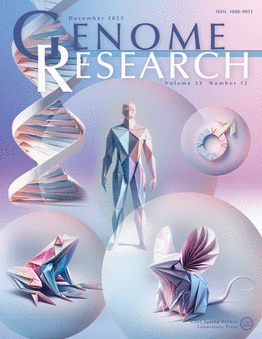利用长读数和长范围脚手架构建和评估新的大鼠参考基因组序列 GRCr8
IF 5.5
2区 生物学
Q1 BIOCHEMISTRY & MOLECULAR BIOLOGY
引用次数: 0
摘要
我们报告了大鼠(Rattus norvegicus)新参考基因组的构建和分析,大鼠是一种广泛使用的实验动物模型生物。基因组参考联盟(Genome Reference Consortium)已将该组配作为大鼠的参考组配,并将其命名为 GRCr8。该汇编采用了 40×Pacific Biosciences (PacBio) HiFi 测序覆盖率,并使用光学映射和 Hi-C 搭架。我们使用了来自雄性 BN/NHsdMcwi (BN) 大鼠的基因组 DNA,该大鼠与之前的参考基因组 mRatBN7.2 属同一品系、同一群体。该基因组是染色体水平的,98.7% 的序列分配给了染色体。所有染色体的大小都比之前的序列集有所增加,K-聚合体分析表明,受试动物是完全近亲繁殖的,基因组表现为一个单倍体序列集。在 3 号、11 号和 12 号染色体的准 rDNA 区域观察到显著的增加。此外,Y染色体的大小增加了三倍,与之前的组合相比,更符合大鼠核型。其他几条染色体也因加入了相当大的离散新区块而增大。这些染色体包含高度重复的序列,并编码了许多以前未注明的基因。此外,大多数染色体都加入了中心粒序列。NCBI RefSeq 对基因组进行了注释,证实了组装质量的提高,并增加了 1100 多个新的蛋白质编码基因。PacBio Iso-Seq 数据来自受试动物的多个组织,与新的组装同时发布,以帮助进一步分析。本文章由计算机程序翻译,如有差异,请以英文原文为准。
Construction and evaluation of a new rat reference genome assembly, GRCr8, from long reads and long-range scaffolding
We report the construction and analysis of a new reference genome assembly for Rattus norvegicus, the laboratory rat, a widely used experimental animal model organism. The assembly has been adopted as the rat reference assembly by the Genome Reference Consortium and is named GRCr8. The assembly has employed 40× Pacific Biosciences (PacBio) HiFi sequencing coverage and scaffolding using optical mapping and Hi-C. We used genomic DNA from a male BN/NHsdMcwi (BN) rat of the same strain and from the same colony as the prior reference assembly, mRatBN7.2. The assembly is at chromosome level with 98.7% of the sequence assigned to chromosomes. All chromosomes have increased in size compared with the prior assembly and k-mer analysis indicates that the subject animal is fully inbred and that the genome is represented as a single haploid assembly. Notable increases are observed in Chromosomes 3, 11, and 12 in the prospective rDNA regions. In addition, Chr Y has increased threefold in size and is more consistent with the rat karyotype than previous assemblies. Several other chromosomes have grown by the incorporation of sizable discrete new blocks. These contain highly repetitive sequences and encode numerous previously unannotated genes. In addition, centromeric sequences are incorporated in most chromosomes. Genome annotation has been performed by NCBI RefSeq, which confirms improvement in assembly quality and adds more than 1100 new protein coding genes. PacBio Iso-Seq data have been acquired from multiple tissues of the subject animal and are released concurrently with the new assembly to aid further analyses.
求助全文
通过发布文献求助,成功后即可免费获取论文全文。
去求助
来源期刊

Genome research
生物-生化与分子生物学
CiteScore
12.40
自引率
1.40%
发文量
140
审稿时长
6 months
期刊介绍:
Launched in 1995, Genome Research is an international, continuously published, peer-reviewed journal that focuses on research that provides novel insights into the genome biology of all organisms, including advances in genomic medicine.
Among the topics considered by the journal are genome structure and function, comparative genomics, molecular evolution, genome-scale quantitative and population genetics, proteomics, epigenomics, and systems biology. The journal also features exciting gene discoveries and reports of cutting-edge computational biology and high-throughput methodologies.
New data in these areas are published as research papers, or methods and resource reports that provide novel information on technologies or tools that will be of interest to a broad readership. Complete data sets are presented electronically on the journal''s web site where appropriate. The journal also provides Reviews, Perspectives, and Insight/Outlook articles, which present commentary on the latest advances published both here and elsewhere, placing such progress in its broader biological context.
 求助内容:
求助内容: 应助结果提醒方式:
应助结果提醒方式:


